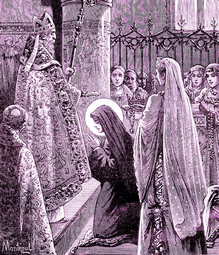Lives of the Saints
Our Models and Protectors
Spiritual Bouquet:
March 3

Saint Cunegundes
Empress
(† 1040)
Saint Cunegundes was the daughter of Sigefried, the first Count of Luxemburg, and Hadeswige, his pious wife. From her cradle her virtuous parents instilled into their daughter the most tender sentiments of piety. When she was of an age to marry, they chose for her spouse Saint Henry, Duke of Bavaria, who at the death of the Emperor Otto III was named King of the Romans and crowned on the 6th of June, 1002. Queen Cunegundes was crowned at Paderborn on Saint Laurence's day.
In the year 1014 she went with her husband to Rome and received the imperial crown with him from the hands of Pope Benedict VIII. With Saint Henry's consent, before their marriage she had made a vow of perpetual virginity. Calumniators afterwards made vile accusations against her, and the holy Empress, to remove the scandal of such a slander, trusting in God to prove her innocence, walked over red-hot ploughshares without being hurt. The Emperor renounced and condemned his own too scrupulous fears and credulity, and from that time on they lived in the strictest union of heart, working together to promote piety and God's honor in every sphere.
Going once to make a retreat in Hesse, Saint Cunegundes fell dangerously ill, and she made a vow to found a monastery at Kaffungen, in the diocese of Paderborn, if she recovered. This she executed in a stately manner, and gave it to nuns of the Order of Saint Benedict. Before it was finished, Saint Henry died in 1024. She earnestly recommended his soul to the prayers of the empire, and especially to her dear nuns, and expressed her longing desire to join the Sisters. She had already exhausted her treasures in founding bishoprics and monasteries and in relieving the poor, and she had therefore little left to give. But intending to embrace perfect evangelical poverty, to renounce all things in order to serve God without obstacle, she assembled a great number of prelates at the dedication of her church of Kaffungen, on the anniversary day of her husband's death, 1025. After the Gospel was sung at Mass she offered on the altar a relic of the true cross, and then, putting off her imperial robes, clothed herself with a poor habit. Her hair was cut off, and the bishop gave her the veil and a ring as a pledge of her fidelity to her heavenly Spouse.
After she was consecrated to God in religion, she seemed to forget entirely that she had been an empress, and served as the last in the house, being persuaded that she was such, before God. She prayed and read a great deal, worked with her hands, and took singular pleasure in visiting and comforting the sick. In this way she passed the last fifteen years of her life.
When her last hour was drawing near, perceiving that they were preparing a cloth fringed with gold to cover her corpse after her death, she ordered it to be taken away; and she could not rest until the promise was given that she would be buried as a poor religious in her habit. She died on the 3rd of March, 1040. Her body was carried to Bamberg and buried near that of her husband. She was solemnly canonized by Innocent III, in 1200.
Reflection. Detachment of the spirit at least, is necessary for those who cannot undertake to enter religion. Every one of you, says Jesus Christ, who does not renounce all that he possesses, cannot be My disciple. (Luke 14:33)
Little Pictorial Lives of the Saints, a compilation based on Butler's Lives of the Saints and other sources by John Gilmary Shea (Benziger Brothers: New York, 1894).